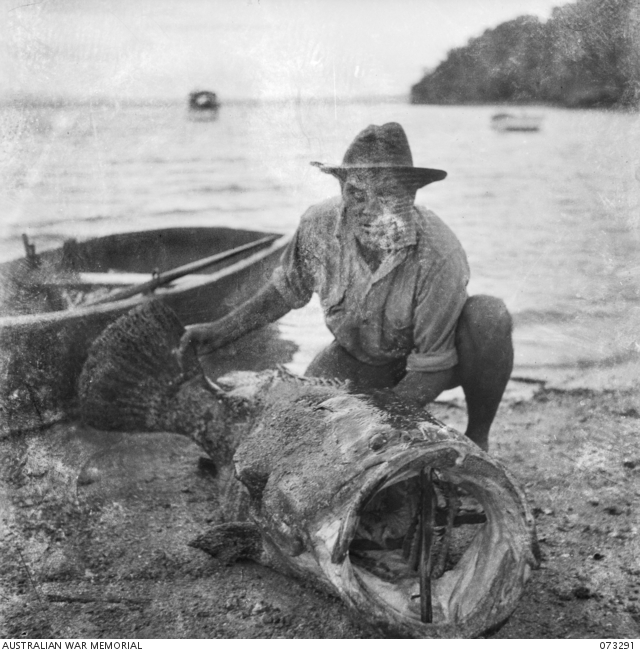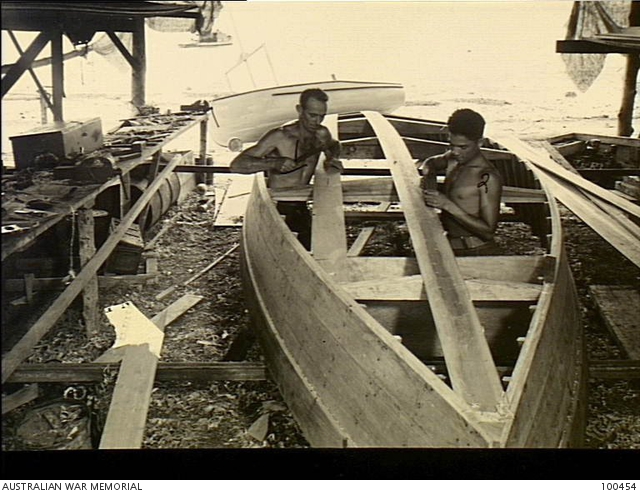Fishing for Victory
To support campaigns in the South-West Pacific during the Second World War, the Australian Army established mobile non-combat supply units to provide and distribute food and supplies. The food-supply network was also intended to reduce competition for combat units’ rations and minimise the need for supply runs.
1 Australian Marine Food Supply Platoon operated in coastal areas of New Guinea and nearby islands from 1943 to 1945. Equipped with fishing boats and equipment, refrigeration and camping equipment, the unit’s men included a mix of army personnel and New Guinea locals. Between them they had a useful mix of fishing experience and local knowledge about edible marine species and coastal conditions.
One of the platoon’s men displays a fish caught while at the Yule Island base, 1944.
The size of the South-West Pacific and competing demands for equipment and rations meant that support units had to be able to operate independently for months at a time in challenging conditions. The fishing platoon’s war diary describes daily fishing expeditions, boat repairs, maintenance of engines and generators, repair of nets and lines, and waiting for parts for refrigeration units required to chill the seafood catches. At times the men built new small boats to assist their work. After an initial period in Port Moresby, the unit moved to Madang, Torokina Island and Yule Island, and were at Bougainville by early 1945.
2/7 Australian General Hospital at Lae, New Guinea regularly received fish from the 1 Marine Food Supply Platoon . A good week of fishing in 1943 enabled the unit to deliver more than 200 kilograms seafood that they had caught, processed and refrigerated, creating a welcome menu for the hospital’s staff and patients. The catch increased with experience, better nets and locating bountiful fishing grounds. While at the Bougainville site, the platoon recorded catching over 1360 kilograms of seafood in a matter of days. This was “a record for the platoon in this or any other area”, the commanding officer noted on 23 August 1945.
In addition to the supply and delivery of seafood, the platoon also transported soldiers to their units after being discharged from hospital and assisted in communications and deliveries between remote outposts and church-led missions on the islands. The delivery of war comfort packages from the Australian Comforts Fund were always warmly received.
Australian Comforts Fund packages for delivery by 1 Marine Food Supply Platoon to a Catholic mission on Yule Island.
Food-collecting trips did not always involve fishing, and could involve visiting local markets and hunting trips. At nearby local markets, bananas and other tropical fruit could be sourced, while hunting trips around the shorelines could include shooting crocodiles. For these trips, it was handy to have the pre-war experiences, skills and knowledge of local islanders.
Weather conditions were often challenging, from intense tropical sun and high humidity to violent storms and cyclones which made fishing impossible. In early 1945, near the unit’s Bougainville site, a three-day gale caused so much damage the men had to search for new fishing grounds, with fishing still poor after the gale subsided. Due to the remoteness of Bougainville Island, the platoon’s self-sufficiency and accumulated experience were important for getting back into action as soon as possible. Despite these challenges, the unit maintained an excellent fishing and delivery record.
In the closing months of 1945 the platoon continued sourcing and providing seafood deliveries between Torokina Island and Bougainville. After receiving a 1 Aust Army redundancy notice on 15 November, the men packed up their gear, cleared the camping area, and used the largest fishing boat to travel to Rabaul. From there they were demobilised and returned to Australia.
The members of 1 Australian Marine Food Supply Platoon could be proud of their wartime accomplishments. They had been self-sufficient and produced and provided food for approximately two years, contributing to the health and well-being of military forces in Papua New Guinea and the South West Pacific. They had also enabled additional communication channels between remote areas and islands, while transporting vital supplies, care packages and military personnel.
The digitisation of the 1 Australian Marine Food Supply Platoon war diaries is part of the Memorial’s project to digitise the holdings of Second Australian Imperial Force and Citizen Military Forces unit war diaries from the archival series AWM52.



